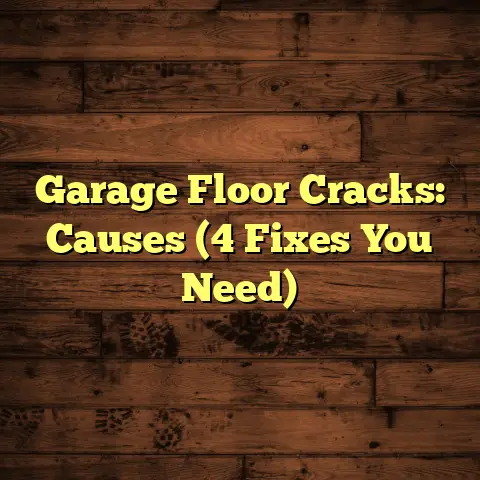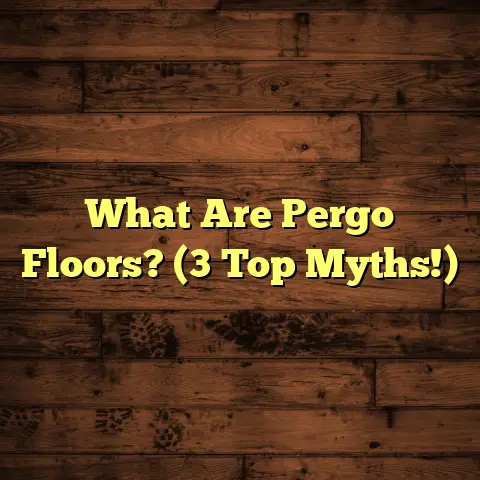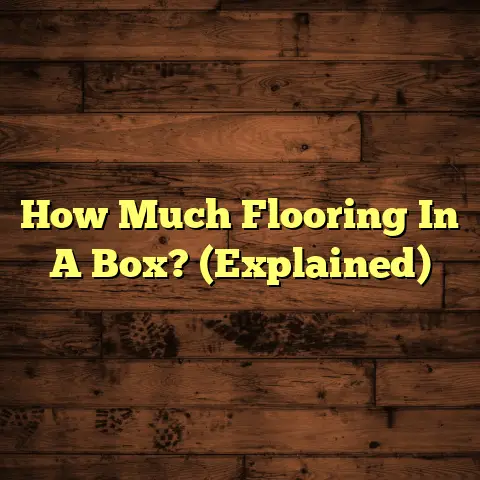Why Floors Creak When I Walk? (4 Causes!)
Warning: This article delves into the common yet often overlooked issue of creaking floors, a phenomenon that can be both annoying and alarming for homeowners.
While some may dismiss these sounds as benign, they can indicate underlying structural problems.
Read on to explore the four primary causes of creaking floors and gain a deeper understanding of this household mystery.
I’ve heard my fair share of creaky floor stories.
It’s a common problem, and honestly, it can be more than just an annoyance.
Creaking can signal underlying issues that, if left unchecked, could lead to bigger, more expensive repairs down the road.
So, why do floors creak when you walk? Let’s dive in.
Understanding Floor Construction
Before we get to the nitty-gritty of why your floors are
singing a creaky tune, let’s quickly review how floors
are built.
Trust me, it’s important!
Overview of Floor Types
Think about the floors you’ve walked on.
Hardwood,
laminate, carpet, tile – they all have different vibes,
right?
They also have very different construction
methods.
- Hardwood: Classic and beautiful, hardwood floors are typically solid wood planks nailed or glued to a subfloor.
- Laminate: A more budget-friendly option, laminate floors are made of a composite material topped with a photographic layer that mimics wood or tile.
- Carpet: Soft and cozy, carpet is installed over a pad, which provides cushioning and insulation.
- Tile: Durable and water-resistant, tile is often used in bathrooms and kitchens and is installed with mortar over a cement board or similar underlayment.
Components of a Floor Structure
Now, let’s look under the pretty surface.
A floor
structure isn’t just the material you see.
It’s a
system!
- Joists: These are horizontal beams that run parallel to each other and support the subfloor. Think of them as the backbone of your floor. They are typically made of wood or engineered lumber.
- Beams: Larger, more substantial supports that joists rest on. Beams transfer the load to the foundation.
- Subflooring: This is the layer directly on top of the joists. It’s usually plywood or OSB (oriented strand board). It provides a smooth, stable surface for the finished floor.
- Finished Floor: This is the material you see and walk on – hardwood, laminate, tile, etc.
Load-bearing is a key concept here.
The entire
structure is designed to distribute weight evenly.
When one component fails or is compromised, it can
affect the whole system and, you guessed it, cause
creaking.
The Science of Sound and Creaking
Okay, let’s get a little scientific. What actually causes that annoying creak?
What Causes Creaking Sounds?
Simply put, creaking is the sound of friction.
Specifically, it’s the sound of two surfaces rubbing
together.
In the case of floors, it’s usually the
subfloor rubbing against the joists, or the finished
floor rubbing against the subfloor.
Think of it like rubbing two pieces of sandpaper together.
The rougher the surfaces and the more pressure you apply,
the louder the sound.
Sound waves are created by these vibrations.
These waves
travel through the air (or through the floor itself) until
they reach your ears.
The type of material the sound
travels through affects how you perceive it.
For example,
a creak traveling through wood will sound different than
a creak traveling through concrete.
Frequency and Decibel Levels
Creaking sounds aren’t all the same.
They vary in
frequency (how high or low the pitch is), and decibel
level (how loud they are).
A high-pitched creak might indicate a small, localized
problem, like a loose nail.
A deep, booming creak could
suggest a more significant structural issue.
While I haven’t personally measured the decibel level of every creaky floor I’ve encountered, I can tell you that even a seemingly quiet creak can be incredibly irritating, especially at night!
The Four Primary Causes of Creaking Floors
Alright, let’s get to the heart of the matter.
In my
experience, these are the four most common reasons why
floors creak.
1. Improper Installation
This is a big one.
I can’t stress enough how crucial
proper installation is.
Cutting corners here is a recipe
for creaky disaster.
Importance of Proper Nailing, Screwing, and Gluing: When installing any type of flooring, it’s essential to use the right fasteners (nails, screws) and adhesives (glue) and to use them correctly.
- Nails: Should be the correct length and type for the material being used. They should be driven in straight and flush with the surface.
- Screws: Offer a stronger hold than nails and are often used to secure subflooring to joists.
- Glue: Provides an extra layer of security and helps to prevent movement between flooring components.
- Nails: Should be the correct length and type for the material being used. They should be driven in straight and flush with the surface.
Common Installation Mistakes:
- Inadequate Spacing: Leaving too little space between floorboards can cause them to rub against each other as they expand and contract, leading to creaking.
- Poor Alignment: If floorboards aren’t properly aligned, they can create uneven surfaces that rub together.
- Using the Wrong Fasteners: Using nails that are too short or screws that are too weak won’t provide adequate holding power.
- Skipping Glue: In some cases, glue is essential for preventing movement and noise. Skipping this step can lead to problems down the road.
- Inadequate Spacing: Leaving too little space between floorboards can cause them to rub against each other as they expand and contract, leading to creaking.
Example: I once had a client whose brand-new hardwood
floors were creaking like crazy.
Turns out, the installer
had used the wrong type of nails and hadn’t bothered with
glue.
We had to redo the entire floor, which was a costly
and time-consuming mistake that could have been avoided
with proper installation.
2. Wood Expansion and Contraction
Wood is a natural material, and it’s constantly
responding to changes in its environment.
Specifically,
humidity and temperature fluctuations cause wood to expand
and contract.
Environmental Factors:
- Humidity: When the air is humid, wood absorbs moisture and expands. When the air is dry, wood loses moisture and contracts.
- Temperature: Wood expands when it’s warm and contracts when it’s cold.
- Humidity: When the air is humid, wood absorbs moisture and expands. When the air is dry, wood loses moisture and contracts.
How Movement Leads to Creaking: As wood expands and contracts, it can create gaps between floorboards or between the subfloor and the joists. When you walk on these areas, the wood rubs together, creating a creaking sound.
Example: I’ve seen homes where the floors are perfectly
silent in the summer but start creaking in the winter when
the air is drier.
This is a classic example of wood
expansion and contraction at play.
Tip: Maintaining a consistent humidity level in your
home can help minimize this problem.
A humidifier in the
winter and a dehumidifier in the summer can make a big
difference.
3. Worn Out or Damaged Components
Over time, the materials that make up your floor structure
can weaken or become damaged.
This is especially true in
older homes.
Aging Materials:
- Joists: Can sag or rot over time, especially if they’ve been exposed to moisture.
- Subflooring: Can delaminate or become soft and spongy due to water damage or insect infestation.
- Joists: Can sag or rot over time, especially if they’ve been exposed to moisture.
Wear and Tear:
- Foot Traffic: Constant foot traffic can wear down flooring materials and loosen connections.
- Heavy Furniture: Heavy furniture can put stress on the floor structure, causing it to sag or shift.
- Structural Shifts: Over time, the entire house can settle or shift, putting stress on the flooring system.
- Foot Traffic: Constant foot traffic can wear down flooring materials and loosen connections.
Loosening of Connections: As materials wear down, nails and screws can loosen, creating more movement and, of course, more creaking
Example: I recently inspected a home where the
subflooring was riddled with termite damage.
The floor
was creaking in almost every room, and in some areas, it
was actually starting to sag.
The solution was to replace
the entire subfloor, which was a major undertaking.
4. Foundation Movement
This is the most serious cause of creaking floors, and it’s
important to address it promptly.
Foundation movement can
affect the entire structure of your home, including the
flooring system.
Causes of Foundation Movement:
- Settling: All homes settle to some extent, but excessive settling can cause problems.
- Soil Erosion: Soil erosion around the foundation can weaken its support.
- Water Damage: Water can weaken the soil around the foundation, causing it to shift.
- Settling: All homes settle to some extent, but excessive settling can cause problems.
Connection to Creaking Floors: When the foundation shifts, it puts stress on the entire house, including the flooring system. This can cause joists to twist, subflooring to buckle, and floorboards to rub together, leading to widespread creaking.
Example: I once worked on a home where the foundation
had shifted due to poor drainage.
The floors were creaking
throughout the house, and there were also cracks in the
walls.
We had to stabilize the foundation before we could
even think about repairing the floors.
Warning Sign: If you notice cracks in your walls or ceiling in addition to creaking floors, it’s a good idea to have your foundation inspected by a professional.
Case Studies and Anecdotal Evidence
Okay, enough with the technical stuff. Let’s talk about some real-life examples.
Case Study 1: The Mystery Creak: A client called me complaining about a single, persistent creak in her living room. It turned out that a heating duct running under the floor had come loose and was rubbing against a joist. A simple fix with some metal tape solved the problem.
Case Study 2: The Old House Blues: Another client had an older home with widespread creaking. After careful inspection, we found that the joists were sagging in several areas. We reinforced the joists with sister joists (additional joists attached to the existing ones), which significantly reduced the creaking.
Expert Opinion: I spoke with a structural engineer who told me that creaking floors are often the first sign of a more serious problem. “Don’t ignore those creaks,” he said. “They’re trying to tell you something.”
Conclusion
So, there you have it – the four primary causes of creaking floors: improper installation, wood expansion and contraction, worn-out components, and foundation movement.
Summary of Key Points: Understanding why your floors are creaking is the first step toward fixing the problem. Don’t ignore those noises! They could be a sign of something more serious.
Final Thoughts: Addressing creaking floors promptly can help maintain the integrity of your home and prevent costly repairs down the road. So, listen to your floors – they’re trying to tell you something!





